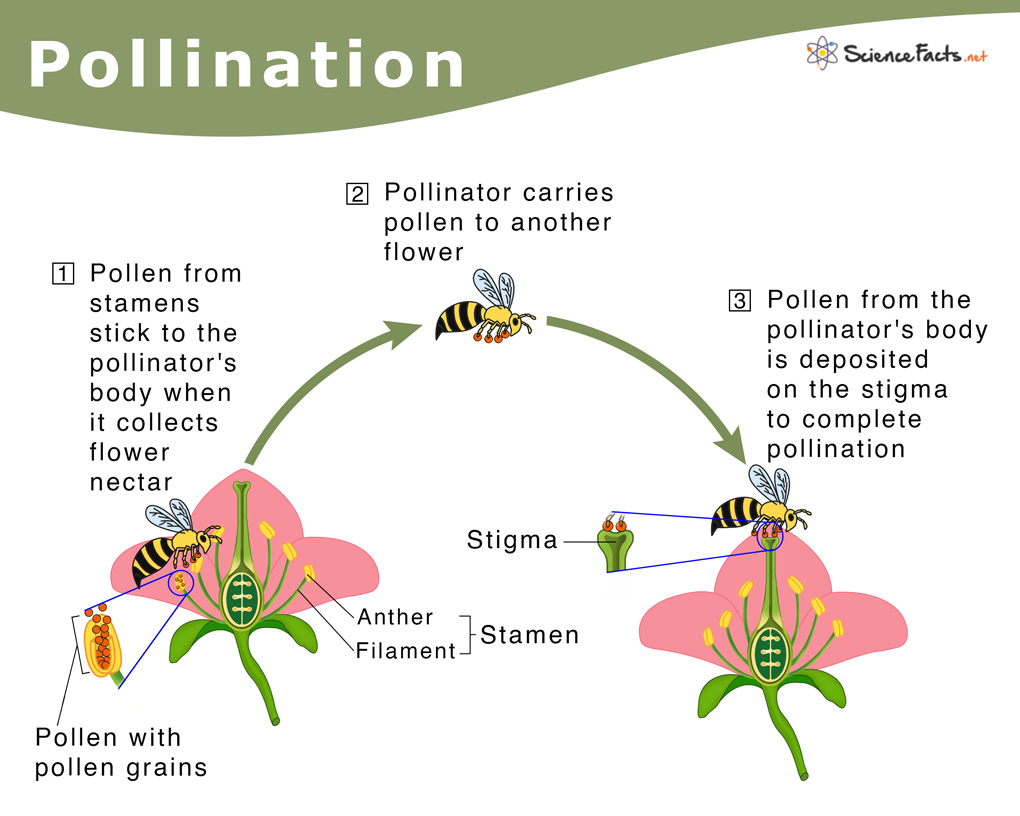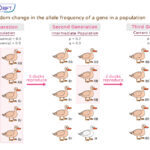Pollination
What is Pollination in Plants
The primary goal of every living organism on earth is reproduction. In flowering plants, the flower is the main reproductive organ. They have seeds within them that contain their genetic information. Reproduction starts when the genetic information is transferred from the male part of a flower to its female part. This process produces seeds that later give rise to a new plant.
The act of transferring pollen from the anther, the male part of a flower, to the stigma, the female part, is called pollination. For pollination to occur, the plants must be of the same species.
How does Pollination Work: Steps of Pollination
Here are the steps through which pollination occurs.
Step 1: The first step is to transfer pollen from the anther to the stigma of the same or different flower.
Step 2: After the pollen’s successful transfer, a pollen tube starts forming along the length of the style. The style is a long stalk that connects the stigma to the ovary of the flower.
Step 3: After the pollen tube is complete, the sperm cells travel through it to reach the ovary. The union of the sperm and egg cells in the ovary results in the formation of a seed.
Step 3: Finally, the seed gets detached from the parent plant, and their dispersal causes a new plant to grow. The new plant participates in pollination to repeat the cycle.
Agents of Pollination: Pollinators
Pollinating agents are known as pollinators. They are biotic (living) and abiotic (nonliving). Here are some examples of pollinators.
1) Biotic
Pollination by Animals (Zoophily)
Various factors such as the flower’s scent, the nectar’s position, and the pollen’s nature are essential for zoophily. They are of three types:
- Pollination by Insects (Entomophily): Colorful, fragrant flowers such as sunflower and orchids attract pollinators such as bees, wasps, ants, beetles, moths, butterflies, and flies. Insects also pollinate aquatic plants such as water hyacinth and lily.
- Pollination by Birds (Ornithophily): Flowers having copious nectar and red petals such as orchids and wildflowers are pollinated by hummingbirds and sunbirds.
- Pollination by Bats (Chiropterophily): White petal flowers with a strong scent that flowers at night, such as java and bauhinia plants.
2) Abiotic
Pollination by Wind (Anemophily)
This type of pollination is observed in forests where the air carries pollen from one tree to another. It can also occur within the same tree. Anemophily is more effective for flowers with free-swinging, light anthers to be carried easily by the wind. Coconut, palm, and maize are some examples of wind-pollinated plants.
Pollination by Water (Hydrophily)
This type of pollination is widespread in plants such as algae, pteridophytes, and bryophytes. They have a mucilaginous covering that protects the pollen grains.
Types of Pollination
There are two types of pollination.
1) Self-Pollination
Transferring pollen from the anther to the stigma of the same flower is called self-pollination. It is the primary type of pollination in plants. Self-pollination is common in plants that contain both male and female sexual parts in the same flower. Beans, peas, lettuce, tomatoes, peppers, and eggplants are examples of self-pollinating plants.
Self-pollinating plants depend less on external factors for their pollination. They depend on wind and other smaller insects for their pollination. Self-pollination can be of two types:
a) Autogamy: Transferring pollen from the anther to the stigma of the same flower.
b) Geitonogamy: Transferring pollen from the anther of one flower to the stigma of another flower, but on the same plant.
Advantages
- Maintains the purity of the race as there is no mix up of genes
- Simple and fast process
- High rate of successful pollination
- Less dependent on external factors such as wind, water, and other pollinating agents to cause pollination
- Less wastage of pollen grains
- Ensures that the fewer dominant characters are eliminated, and only the dominant characters are expressed
Disadvantages
- Involves no mixing up of genes, and thus new characters or traits are not incorporated
- Causes a decrease in the vigor and vitality of the race
- Offspring are borne with less immunity and thus are more prone to diseases
2) Cross-Pollination
Transferring pollen grain from the anther of one flower to the stigma of another flower is called cross-pollination. This type of pollination is complex, involving flowers that are genetically different from each other. Grasses, daffodils, pumpkins, and apples are examples of cross-pollinating plants.
Cross-pollination always depends on another agent for pollination to occur. The agent can be biotic such as bees, birds, insects, and animals or abiotic such as wind and water.
Cross-pollination, when done artificially by humans, is called artificial pollination. This process is utilized to overcome external difficulties in pollination, increase the yield of crops, and introduce some new traits or characters in the plant.
Advantages
- Introduces new traits that are of good vigor and vitality
- Improves immunity against diseases and also to the changing environment
- Eliminates the recessive and nonessential characters
- Reproduces in unisexual plants
Disadvantages
- Massive wastage of pollen grains
- Chances of elimination of good qualities and incorporation of nonessential characteristics in the offspring
Why is Pollination Important
Biological Importance
- Helps in the reproduction of flowering plants through the formation of seeds and then fruits
- Produces food for humans and animals. More than half of the world’s fat and oils such as oil palm, canola, and sunflowers come from pollination. Almost all fruit and grain crop production in the U.S. depends on pollination.
- Maintains genetic diversity within a plant population.
- Helps water, oxygen, and carbon cycle to continue in nature.
Environmental Importance
Flowering plants produced through pollination helps in:
- Cleaning up the environment by producing oxygen and reducing the carbon dioxide level of the atmosphere.
- Purifying the rainwater before reaching the water table.
- Preventing soil erosion.
Economic Importance
- Helps in the production of food, medicines, fibers, oils, resins, latex, gums, tannins, soaps, waxes, and plant-based dyes.
FAQs
Ans. Pollination is the act of transferring pollen grains from the male part of a flower, called anther, to the female part, called the stigma. In contrast, fertilization is the fusion of the male and female gametes in plants that occurs after pollination.
Ans. Self-pollination involves the transfer of pollen grains from the anther to the stigma of the same plant’s same or different flower. In contrast, cross-pollination involves transferring pollen grains from the anther to the flower’s stigma in two different plants.
Ans. Sunflower, dahlia, dandelion, lavender, marigold, daisy, and milkweed are common flowers that attract pollinators.
Ans. Pollinators help in the reproduction of flowering plants by forming seeds and fruits.
Ans. Yes, mosquitoes can pollinate as they can carry pollen grains between flowers.
Ans. Yes, months are good daytime pollinators.
-
References
Article was last reviewed on Friday, February 3, 2023






